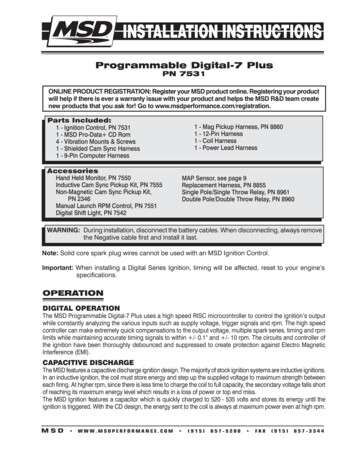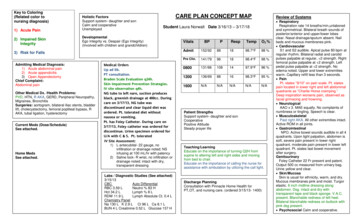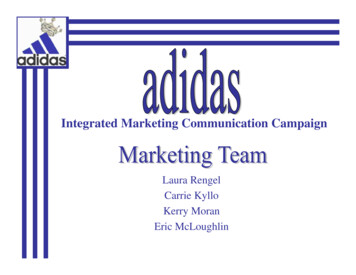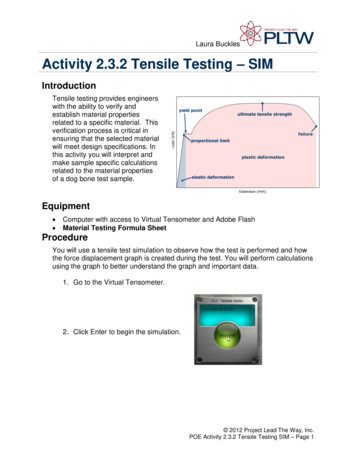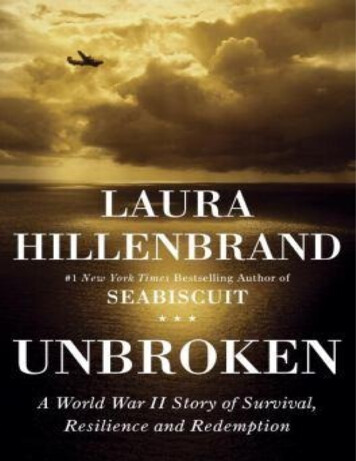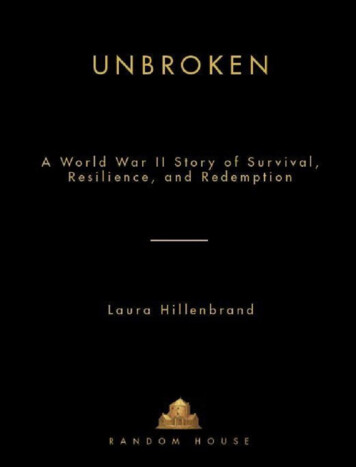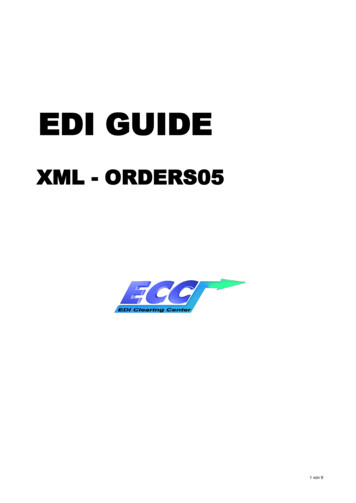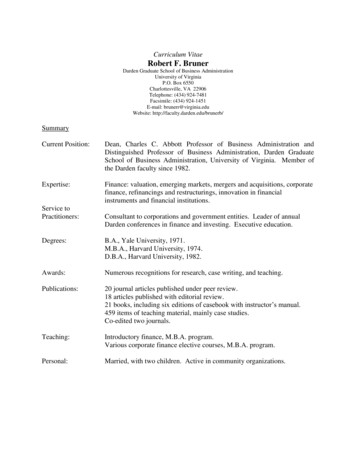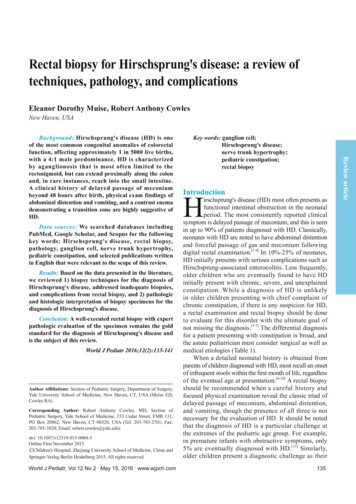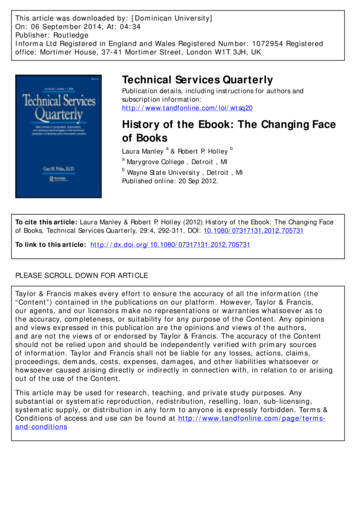
Transcription
This article was downloaded by: [Dominican University]On: 06 September 2014, At: 04:34Publisher: RoutledgeInforma Ltd Registered in England and Wales Registered Number: 1072954 Registeredoffice: Mortimer House, 37-41 Mortimer Street, London W1T 3JH, UKTechnical Services QuarterlyPublication details, including instructions for authors andsubscription istory of the Ebook: The Changing Faceof BooksaLaura Manley & Robert P. HolleyabMarygrove College , Detroit , MIbWayne State University , Detroit , MIPublished online: 20 Sep 2012.To cite this article: Laura Manley & Robert P. Holley (2012) History of the Ebook: The Changing Faceof Books, Technical Services Quarterly, 29:4, 292-311, DOI: 10.1080/07317131.2012.705731To link to this article: SE SCROLL DOWN FOR ARTICLETaylor & Francis makes every effort to ensure the accuracy of all the information (the“Content”) contained in the publications on our platform. However, Taylor & Francis,our agents, and our licensors make no representations or warranties whatsoever as tothe accuracy, completeness, or suitability for any purpose of the Content. Any opinionsand views expressed in this publication are the opinions and views of the authors,and are not the views of or endorsed by Taylor & Francis. The accuracy of the Contentshould not be relied upon and should be independently verified with primary sourcesof information. Taylor and Francis shall not be liable for any losses, actions, claims,proceedings, demands, costs, expenses, damages, and other liabilities whatsoever orhowsoever caused arising directly or indirectly in connection with, in relation to or arisingout of the use of the Content.This article may be used for research, teaching, and private study purposes. Anysubstantial or systematic reproduction, redistribution, reselling, loan, sub-licensing,systematic supply, or distribution in any form to anyone is expressly forbidden. Terms &Conditions of access and use can be found at s
Technical Services Quarterly, Vol. 29:292–311, 2012Copyright Taylor & Francis Group, LLCISSN: 0731-7131 print/1555-3337 onlineDOI: 10.1080/07317131.2012.705731History of the Ebook:The Changing Face of BooksLAURA MANLEYMarygrove College, Detroit, MIDownloaded by [Dominican University] at 04:34 06 September 2014ROBERT P. HOLLEYWayne State University, Detroit, MIThe history of the ebook and e-readers began before World WarII with Vannevar Bush, who conceived the memex as a way forindividuals to store and read increasing amounts of availableinformation. Project Gutenberg started digitizing texts in 1971. Inthis article the authors trace the history of ebooks and e-readersfrom these early beginnings to the current explosion of ebook use.While libraries started to experiment with ebooks relatively late,they have jumped upon the ebook bandwagon within the last fewyears. Problems have arisen with proprietary formats, licensingrather than ownership, and the mechanics of ebook circulation.KEYWORDS ebooks, e-readers, Kindle, NookHISTORY OF THE EBOOK:THE CHANGING FACE OF BOOKSConsider a future device for individual use, which is a sort of mechanizedprivate file and library. It needs a name, and, to coin one at random,‘‘memex’’ will do. A memex is a device in which an individual stores allhis books, records, and communications, and which is mechanized sothat it may be consulted with exceeding speed and flexibility. It is anenlarged intimate supplement to his memory.‘‘As We May Think’’ (Vannevar Bush, 1945)Received 5 March 2012; accepted 10 April 2012Address correspondence to Laura Manley, Marygrove College, 8425 West McNichols,Detroit, MI 48221. E-mail: lmanley3312@marygrove.edu292
Downloaded by [Dominican University] at 04:34 06 September 2014History of the Ebook293The history of the ebook started much earlier than most people think. Muchlike the printing press, the ebook has the potential to change how theworld reads. While the idea of Guttenberg’s printing press spread rapidlyacross Europe in just 30 years, the concept of the ebook is taking somewhat longer to catch on. Although the ebook trade has exploded duringthe past five years in what some call the ebook revolution, ebooks havebeen around much longer. The ebook’s roots can be traced back to earlycomputers. Technology has developed by increased miniaturization over theyears. To get an idea of how this has happened with ebooks, considerthe telephone. As much of a visionary as Alexander Graham Bell was,he would be in awe at the evolution that the telephone has undergoneover the past 140 years. The development of the ebook is similar. Whenthe ebook was conceived, ‘‘the typical computer of this era was the sizeof two or three refrigerators back to back’’ (Hiltzik, 1999, p. xxi). In thisarticle the authors will explore the origins of the ebook and follow itsdevelopment until 2012. While this study is not exhaustive, we will narrate the history of the ebook from its humble beginnings to its currentpopularity.DEFINITIONBefore going any further, it is essential to define the term ‘‘ebook.’’ Likemany technologies, the definition of and vision for ebooks has changed overtime. The word ‘‘ebook’’ is an ambiguous umbrella term that encompassesseveral concepts. A review of the literature further confirms that the wordcarries multiple meanings that depend upon context. Morgan (1999) definesebooks as being the hardware/software combination specifically designedfor reading, in contrast with e-texts written in hyper-text markup languageand viewable on a computer. Balas (2000) also cautions readers not toconfuse e-texts with ebooks and stresses that ebooks must be read onan ebook reader or with special software. Hawkins (2000) expands thedefinition of ebook to include the contents of any book made availablein electronic form through four different methods: a downloadable, dedicated ebook; a dedicated ebook reader; a web accessible ebook; or aprint-on-demand book. The changing definition of the ebook throughoutthe years can be attributed to market trends. While the first ebook readerswere multifunctional, they developed into single function devices as theybecame more popular. The latest trend, reported by Liliputing (2010), isfor the devices to once again become multifunctional as seen in the Nook,which can be used as a primitive Web browser and can run some Androidapps (‘‘Firmware Update,’’ par. 1). For the purpose of this article, we willuse Hawkins’ definition but exclude any substantive discussion of print-ondemand.
294L. Manley and R. P. HolleyDownloaded by [Dominican University] at 04:34 06 September 2014VANNEVAR BUSH AND THE MEMEXThe idea for an electronic book was first presented to the scientific community in Vannevar Bush’s essay ‘‘As We May Think’’ (1945). Bush speaks of thedifficulty researchers faced even then from the vast amount of informationavailable. Bush (1945) states: ‘‘The investigator is staggered by the findingsand conclusions of thousands of other workers—conclusions he cannot findtime to grasp, much less to remember, as they appear’’ (p. 89). Bush felt thatinformation left trails and that one document would lead to information inanother. He thought that a personal device, where that the researcher couldstore information, would make the job of the researcher considerably easier.Bush was addressing what Colin Burke (1994) refers to as the ‘‘library problem’’ (p. 99). After World War II, both librarians and patrons were encountering difficulties in finding what they wanted in the mass of available information, the phenomenon now known as information overload (Burke, 1994).Although Bush did not publish his essay ‘‘As We May Think’’ until1945, he actually wrote the article in the late 1930s. Originally titled the‘‘Mechanization and the Record,’’ Bush sent a rough draft to Eric Hodges,publisher of Fortune Magazine, on December 7, 1939 (Nyce & Kahn, 1991).Bush later declined Fortune’s offer to publish the manuscript due to concernover whether or not it would reach the right readers. Bush was lookingfor backers to fund the development of ‘‘memex.’’ Burke (1991) explainsthat Bush ‘‘saw little chance that someone would provide funds for sucha speculative device’’ (p. 146). As it turns out, the article would not bepublished until 1945 in The Atlantic, nearly six years after it was written.The device described in Bush’s ‘‘As We May Think’’ was never built.Bush did manage to secure funding for a memex-like device, but his career headed in other directions. Bush left Cambridge to head the CarnegieFoundation in Washington. Three graduate students worked on the memexproject (Burke, 1991). Despite the fact that Bush outlined their tasks andheld them to a schedule, the end product was not the personal machineenvisioned by Bush. Instead, the ‘‘Rapid Selector,’’ the name for the finishedproduct, ran the entire length of a large room (Burke, 1991). Bush’s effortsdid inspire the work of Alan Kay, who would create the world’s first portablecomputer, as well as the work of Douglas Englebart and Ted Nelson, whodeveloped Bush’s notion of information trails into what we know today ashypertext.ALAN KAY AND THE PORTABLE LIBRARYIt was not until nearly 30 years later that Bush’s idea of a portable, personallibrary began to take form. In Alan Kay’s 1969 doctoral thesis, he describedan early prototype of a small personal computer. Unfortunately, technology
Downloaded by [Dominican University] at 04:34 06 September 2014History of the Ebook295at that time was not advanced enough for Kay to turn his prototype intoa reality. Kay went to work at the Xerox Palo Alto Research Center (XeroxPARC), which focused on basic research and whose goal was to invent the‘‘office of the future’’ (Barnes, 2003, par. 8). During his career at the XeroxPARC, Kay encouraged co-workers to design small notebook computers.Leading the Learning Research Group at Xerox PARC, Kay hired peoplewith like interests who believed in interactive computers and the possibilityof notebook-sized computers (Kay, 2000). Unfortunately, technology had stillnot been invented that could make the portable computer a reality.Kay worked on children’s learning software until technology caught upwith his ideas. He saw the potential for the computer to become a communication medium. Susan Barnes (Kay, 2000) explains that Kay envisioneda medium that could represent, communicate, and animate words, images,and sounds. He referred to the images presented on a computer screenas dynamic simulations and thought that they would have the potential tosurpass the book as a form of communication (Kay, 2000). Kay’s unofficialmotto was ‘‘The best way to predict the future is to invent it’’ (Barnes qtd.Kay, 2007, p. 19).THE ALTOWhile Kay was working on the programming language that would one day beknown as SmallTalk, Chuck Thacker developed the circuitry that would makepossible Kay’s dream of a computer the size of a notebook. The prototypefor the first notebook-sized computer was called the ‘‘Alto.’’ In a 1971 PARCmemo, Kay writes: ‘‘In the 1990s there will be millions of personal computers.They will be the size of notebooks of today, have high-resolution flat-screenreflective displays, weigh less than 10 pounds, and have 10 to 20 times thecomputing storage capacity of the Alto. Let’s call them Dynabooks’’ (Barnes,2007, p. 23).The only problem was that the Alto cost nearly 10,000 to build. Onthe upside, the folks at Xerox PARC were nearly 10 years ahead of theircompetitors Apple and IBM (Hiltzik, 1999). In April 1973, the first Altobecame operational and displayed an animated image of the Cookie Monster,a Sesame Street character (Hiltzik, 1999). Vannevar Bush and Alan Kay’sdream of a portable electronic book was starting to become a reality.Even though Alto was the prototype for the laptop computer, it was inactuality more the size of an early desktop computer. An interim Dynabook,the Alto was shaped like a small box into which you could put a disk.Each disk could store approximately 1,500 pages. The Alto was controlledby a mouse and had a desktop with graphical icons. The pages lookedprofessionally typeset and displayed graphic images. Having a screen withthe dimensions 8.500 1100 , it looked somewhat like a small television set.
296L. Manley and R. P. HolleyIn 1988, when most users had shared access to a mainframe computer,Chuck Thacker reflected that it was hard for people to believe that an entirecomputer was required to meet the needs of one person (Barnes, 2007).Downloaded by [Dominican University] at 04:34 06 September 2014THE GRID COMPASS COMPUTERAlthough the Alto had a running start, Kay’s Dynabook design was not thefirst portable compact computer. In 1979, William Morridge developed thefirst actual laptop computer for Grid Computer Systems Corporation. Knownas the Grid Compass Computer, it weighed less than 20% of any other computer that had similar computing capabilities (Ghaoui, 2006). As things turnedout, it was Toshiba that manufactured the Dynabook in 1986, although it wasknown by that name only overseas where it was first marketed (ToshibaCorporation, 2009, par. 1). Considered a notebook, the Dynabook had abacklit-liquid-crystal display monitor, a word processor, and a spreadsheetas well as other applications.MICHAEL HART AND PROJECT GUTENBERGWhile Alan Kay’s idea of ebook hardware was still in its infancy, MichaelHart had the idea to create the world’s first ebook library. In 1971, whatbecame known as the Project Gutenberg began at the University of IllinoisMaterials Research Lab on the Xerox Sigma V mainframe. Having beengiven 100,000,000 worth of computer time, Michael Hart quickly judgedthat computer time would best be used for storage and retrieval purposes.Using the American Standard Code for Information Interchange (ASCII), hefound that he could duplicate a file an infinite number of times and sendit to multiple computers via ASCII text with its alphanumerical characterstranslated for computers into binary bits (Hart, 1992, par. 7). Hart dubbedthis process of duplicating files ‘‘Replicator Technology.’’ ‘‘The concept ofReplicator Technology is simple; once a book or any other item (includingpictures, sounds, and even 3-D items) can be stored in a computer, then anynumber of copies can and will be available’’ (Hart, 1992, par. 6). By usingthe ASCII file format, 99% of all the computers around the world could readand access the files.The first text made available was the Declaration of Independence,followed by the Bill of Rights. Hart’s project had two goals, to be low incost and easy to use. The original goal of Project Gutenberg was to have10,000 books available in electronic format by the year 2001. A blog postingby Michael Hart (2010) states that on August 31, 2010, Project Gutenberghad surpassed 37,500 titles and planned on having made available 40,000ebooks by its 40th year celebration (par. 1).
History of the Ebook297Downloaded by [Dominican University] at 04:34 06 September 2014SUPERBOOK SOFTWAREThroughout the history of ebook development, new technology continued toenhance ebook usability. One such technology, developed at Bell Communication and known as SuperBook, revolutionized ebook navigation. Remde,Gomez, and Landauer (1987) explain that SuperBook software preprocessestext and turns it into a formatted, searchable book. SuperBook softwareformats text to a standardized title format, table of contents, and page/wordlook up. SuperBook can build an index to find all occurrences of a word aswell as use Boolean combinations to improve searching. SuperBook also allowed the user to add annotations. When asked if SuperBook was hypertext,Remde et al. (1987) cite Bush (1945) and explains that, in spirit, SuperBookaccomplishes what hypertext sets out to do. In actuality, SuperBook is nota hypertext system, but rather a different solution to the limitations of theprevious linear construction of ebooks.CD-ROM COMPANIONSIn 1989, Martin (n.d.) explains that Bob Stein and his company Voyagerreleased Beethoven’s Symphony No. 9, the first title in their line of CD-ROMCompanions. The package included a copy of the original score, music bythe Philharmonic Orchestra, and a commentary. The format was so popularthat the company used it for 13 years. Lambert, Ropiequet and Gates (1986)explain that an optical data disc-storage technology, such as CD-ROM, allowsfor ‘‘enormous volumes of textual, visual, and/or audio data to be storedin a very small, highly-resistant-to-damage piece of hardware’’ (p. 252).Voyager’s CD-ROM Accompaniments were the precursor to the company’sExpanded Book Toolkit software. The Expanded Book Toolkit retailed forjust under 300 and allowed consumers to create their own electronic books.Consumers were now able to make CD ROM’s similar to what Voyagerhad on the market. By 1996, the market for CD ROM had waned; andthe company had financial difficulties. Vickers (1997) in part credits failingCD ROM sales in part to the lure of the Internet.BOOKMANAGERIn 1989, IBM introduced BookManager software products that used GeneralMarkup Language, allowing files to be viewed on many platforms. Amongthe products under the BookManager name were BookManager BUILD andBook Manager READ. BookManager BUILD created the online books tobe used by BookManager READ. BookManager READ displayed, searched,and managed the online books and bookshelves. In a study done on the
298L. Manley and R. P. Holleyusability of a manual created with BookManager products, Hendry et al.(1991) found that inexperienced users underutilized the index, relied heavilyupon navigating by paging, and seldom used the search features or thetable of contents to find information. This would suggest that users werenot entirely comfortable using books accessed electronically. BookManagerproducts, however, are still available for download today; and the IBMwebsite offers technical support (Reitz, 2004, p. 213).Downloaded by [Dominican University] at 04:34 06 September 2014SONYKoppel (1991) explains that the idea for the Sony Data Discman occurredin 1988 when Sony engineers noticed how popular pocket-sized electronicnotebooks were with younger employees. The Sony Data Discman is amodified version of Sony’s portable compact disc player. The Data Discmancan store up to 200,000 pages of text on the same discs that once playedonly music. ‘‘The Data Discman Electronic Book Player plays both audio CDsingles and 8 cm CD-ROMs. It weighs 1.5 pounds (with battery), measures4.25 2 5.25,’’ and includes a small QWERTY keyboard with a cursor pad.The 3.400 diagonal LCD screen can display 30 characters by 10 lines. Eachcharacter is a sharp 8 16 pixels. It is battery operated and provided threehours of use’’ (Keep, McLaughlin, & Parmar, 1993, par. 2). The Discman soldfor about 450 in Japan. The disks were pricey and ranged from 125 to 145a piece. The Discman was introduced to the American market in November,1991, at a price of 550 but had little success outside of Japan.Rogers (1992) reports that in the fall of 1992 Sony launched the CD-ROMXA player, also known as the Sony Bookman. The Bookman retailed for 995 and played full sized CD-ROM Discs on a MS DOS platform, unlike theDiscman which played smaller discs. Keep et al. (1993) report that the ‘‘SonyBookman was larger, weighing 2 pounds and measuring 7 2 6.00 It hadtwo notable differences from the Data Discman: it played full-length audioCDs and CD-ROMs and was a DOS-compatible 80286 computer with 640 KBof RAM. The monochrome display was 4.500 diagonally and supported 300 200 resolution (Keep et al., 1993, par. 9). Even pricier than the Discman,the Bookman hit the American market at 900. Sony also partnered withMicrosoft to develop additional software for the Bookman. Although initialsales were promising, Sony failed to create a sust
a Marygrove College , Detroit , MI b Wayne State University , Detroit , MI Published online: 20 Sep 2012. To cite this article: Laura Manley &a

